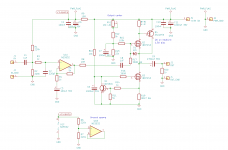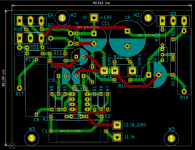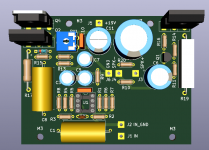Hi,
here is my take on simple low power 5W class A amplifier. Inspired by ACA I wanted to have lower distortion and higher damping factor then ACA.
Amplifier sounds better than ACA. More resolution, more dynamics, better bass.
Happy listening!
here is my take on simple low power 5W class A amplifier. Inspired by ACA I wanted to have lower distortion and higher damping factor then ACA.
Amplifier sounds better than ACA. More resolution, more dynamics, better bass.
Happy listening!
Attachments
One feature of ACA that people complain about, is its lack of turn-on / turn-off muting relay. The loudspeakers make a "thump" sound at turn-on and at turn-off. Maybe you could add this type of circuitry here with no increase in PCB area; there appears to be a large empty zone below C6.
Oh, and you could eliminate R6 and R7 simply by connecting U1 pin5 to U1 pin1.
Oh, and you could eliminate R6 and R7 simply by connecting U1 pin5 to U1 pin1.
One feature of ACA that people complain about, is its lack of turn-on / turn-off muting relay. The loudspeakers make a "thump" sound at turn-on and at turn-off. Maybe you could add this type of circuitry here with no increase in PCB area; there appears to be a large empty zone below C6.
Oh, and you could eliminate R6 and R7 simply by connecting U1 pin5 to U1 pin1.
I like to have muting relay circuitry on separate PCB, so I can use it with other amps too.
I like the thump. Tells the driver to wake up, demagnetizes the loudspeaker cable
(earth's field settles in when not in use) and jazzes up the electrons for a more
lively characteristic.

(earth's field settles in when not in use) and jazzes up the electrons for a more
lively characteristic.

My kids find it highly amusing and have insisted that anything else I build in the future also makes a farting noise on startup.
I assume that its due to the large value of C2, so as a follow on question, does a large value of C3 on the M2 have the same effect?
I assume that its due to the large value of C2, so as a follow on question, does a large value of C3 on the M2 have the same effect?
I like the thump. Tells the driver to wake up, demagnetizes the loudspeaker cable
(earth's field settles in when not in use) and jazzes up the electrons for a more
lively characteristic.

I like it too, but oftentimes I can barely hear it, and if it has a positive effect on the music reproduction, all the better. (No, I don‘t switch on-off-on-off just to hear it, but I switched back to my Onix oa21 which has a loud THUMP when switching on [emoji23])
Many ACA builders use a chassis so small there is no room for a separate PCB.I like to have muting relay circuitry on separate PCB, so I can use it with other amps too.
However, since this PCB has empty space, and since the cost of adding those traces and footprints to the board is zero: you might consider doing so, as a magnanimous gesture of noble benevolence, towards builders who badly want a muting function. Builders who don't want it at all, can of course omit those components and solder jumper wires where the relay contacts would be stuffed. And the cost to them is zero. Zero extra square mm of PCB area, zero dollars worth of extra components for an unwanted mute circuit.
Not to mention the "marketing benefits" of offering a feature which the bog standard ACA board lacks.
_
Last edited:
I like the thump. Tells the driver to wake up, demagnetizes the loudspeaker cable
(earth's field settles in when not in use) and jazzes up the electrons for a more
lively characteristic.

Someone has a sense of humour 😀
Someone has a sense of humour 😀
Yes , and especially when you read some arrogant words like these : " Amplifier sounds better than ACA. More resolution, more dynamics, better bass "
this is Pass Labs section , some respect won't hurt 😉
.
Last edited:
Turn-on thumb destroyer is easy, but how to get faster than the turn-off thumb to kill it? And I like the startup fart, not the turn-off tock.
... how to get faster than the turn-off thumb to kill it?
I am confident that the same designer who is able to achieve an amplifier which sounds better than ACA, with more resolution, more dynamics, better bass, can design a muting circuit effective at both turn-off and turn-on. Or, to save time, copy someone else's effective circuit that works well in another audio product / project.
Yes , and especially when you read some arrogant words like these : " Amplifier sounds better than ACA. More resolution, more dynamics, better bass "
this is Pass Labs section , some respect won't hurt 😉
.
Those words werent meant as arrogant. It is simply fact, that this amplifier has lower distortion and higher damping factor then ACA. I have heard both amplifiers and this one handles complex music and higher volumes better.
I am confident that the same designer who is able to achieve an amplifier which sounds better than ACA, with more resolution, more dynamics, better bass, can design a muting circuit effective at both turn-off and turn-on. Or, to save time, copy someone else's effective circuit that works well in another audio product / project.
I gave design for free, including KiCAD project files. Feel free to modify circuit as you want.
OK, I see power on/off thumps are accepted, asymmetric power supplies are hot again and electrolytic caps are in vogue too. Input cap should then also be electrolytic IMHO for true retro experience.
Sorry for my critical comments but why is audio going back to things that have been improved the last decades?
Sorry for my critical comments but why is audio going back to things that have been improved the last decades?
Last edited:
Please don't forget: the original Amp Camp Amp, of which this is a spin-off, has a single "asymmetric" power supply, making it especially easy to operate from a laptop "power brick" AC to DC converter. The ACA has an electrolytic coupling capacitor on its output. ACA has an electrolytic coupling capacitor at its input. ACA has a turn-on thump and a turn-off thump, which several commenters in this thread have acknowledged and in fact praised.
Hi,
here is my take on simple low power 5W class A amplifier...
It looks like a fun little amp. Thanks for taking the time to not only design it but put all the info out in such a complete format.
What is annoying is that this design is compared to the ACA at all. It is in no way even near the same ballpark as the ACA in terms of its design, except that they are both 5W and have a single ended supply....
- Home
- Amplifiers
- Pass Labs
- SE 5W MOSFET CFP


